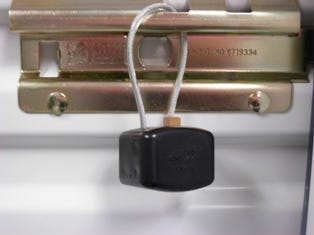The latest security technology to be featured at self-storage facilities across the nation is radio frequency (RF) wireless-alert systems. These high-tech systems are capable of warning self-storage tenants by text-message notification whenever theres a possible intrusion into their respective units or stored assets, and can act as a crime deterrent.
May 14, 2011

By Katie Pavlasek
The cornerstone of every self-storage facility is its security. Without a quality system, customers stored goods are vulnerable to theft, and the self-storage investment could be in jeopardy.
The latest security technology to be featured at self-storage facilities across the nation is radio frequency (RF) wireless-alert systems. These high-tech systems are capable of warning self-storage tenants by text-message notification whenever theres a possible intrusion into their respective units or stored assets, and can act as a crime deterrent. Lets take a closer look at how these new systems work.
Functionality
When a RF wireless device experiences the slightest tamper, the authorized renter of the unit receives a text message within 60 seconds of the intrusion, announcing the date and time the unit was opened. This technology is only available with RFID (Radio Frequency Identification). A constant communication link is engaged between each activated wireless-mobile device and an onsite reader.
Each reader rapidly transfers the information from the opened or broken wireless-alert device to an online Internet server. The server sends an open text-notification message directly to all respectively subscribed mobile phones. To ensure adequate coverage, each wireless reader is positioned to receive periodic signals from wireless-alert devices up to a 1,000 feet radius, providing total project coverage with a minimal quantity of reader units.
There are an unlimited number of subscribers for each wireless-alert unit, so each tenant on the unit can receive intrusion notifications. To generate revenue, operators can charge a rental fee, or simply tack the cost of the device onto the units rental rate. The devices also cost a fraction of the price to adding a hard-wire security system. Payback of the investment is typically 18 months.
Types of Devices
There are currently three models of wireless-alert devices available in the self-storage market, each with similar technology and text-messaging capabilities, engineered to be application-specific. They include:
Door installation. This device is installed with the tenants padlock when securing the self-storage door. The device must be opened to properly unlock the unit door, immediately interrupting the sustained communication link with the closest reader. 
In the unit. Theres also a wireless-alert device that can be installed inside the respective storage unit, making it tamper-proof and out of harms way. This model is instantly activated when the standard mini-lock is disengaged from the perimeter track attachment prior to the door opening.
Motion detection. The last device instantly detects motion when disturbed. Its ideal for RVs, boats or other valuable assets placed in a storage unit or inside a vehicle parked under a canopy or in a storage lot.
Facility Marketing
Self-storage operators who offer wireless-alert devices can use the security product as a way to differentiate themselves in the market. While most facilities now offer a number of security measures including video surveillance and wireless unit alarms, few have tapped into this new technology. Offering wireless-alert devices will also gain additional marketing capabilities to current and past customers via unlimited text advertisements.
RF wireless technology complements a self-storage facility unlike any other product currently offered in the security market today. Wireless-alert systems can be advertised as individual-unit alarms for just a fraction of the usual installation cost, all while adding rental income to an operators bottom line. In todays self-storage market, operators should take advantage of emerging technology to help them win new business at a price they can afford.
Katie Pavlasek is the business development manager for PureRFid, which offers the LockAlert, QuickAlert, MotionAlert and other radio-frequency identification products. Shes been with PureRFid for nearly two years, and has worked in the security industry for six years in residential homes and commercial buildings. For more information, visit www.purerf.com .
You May Also Like





